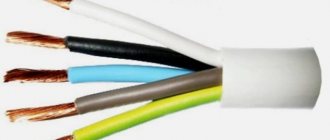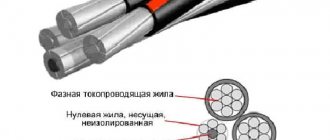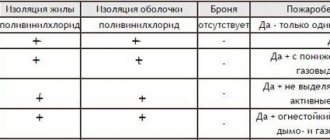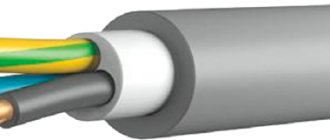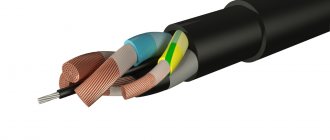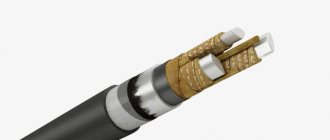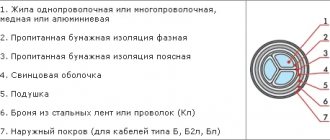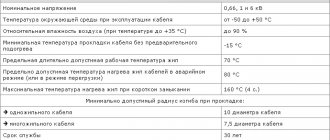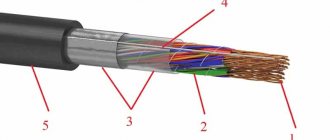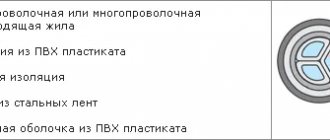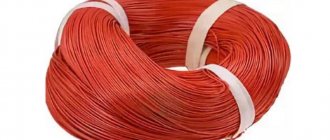What is a PVS wire and its decoding
Based on the name, this is a wire (this is indicated by the first letter - P), enclosed in polyvinyl chloride insulation (the second letter in the abbreviation - B), used as a connecting wire (C). Below is a table that shows the characteristic features for various types of this wire, in accordance with the systematization according to GOST 7399-97.
Systematization table.
| Name | Form | Design features | Characteristics | ~Unom | ||
| Number of cores | Flexibility | Type of insulation and sheath | ||||
| PVS | round | 2-5 | flexible | PVC | — | 380 V |
| PVS ng | PVC | Group installation allowed | ||||
| PVS ng-LS | Low smoke emission PVC | Group installation allowed | ||||
| PVSP | flat | 2 | PVC | — | ||
Marking is carried out according to the following principle: [TYPE] [number of cores] – [cross-section]. It is applied to the outer shell.
Example of PVS wire marking
Decoding of PVS cable
PVA wire has a fairly simple decoding, where the letter “P” indicates the name of the product - wire, “B” refers to vinyl insulation, and “C” indicates the type of connection when the cores are in one common sheath. In this case, the cable will have a circular cross-section. The letter “P” in the product name indicates parallel placement of the wires, due to which the wire will have an oval cross-section.
It is worth noting some points here:
- The PVS wire is marked from the outside. In this case, deciphering the cable may be difficult because the name, in addition to letters, also contains numbers.
- After the letters, the first number, as a rule, can be: 2, 3, 4 or 5. This designation indicates the number of cores in the wire.
- Next in the marking is an “x”, followed by a second number, be it: “0.75”, “1.00”, “1.50” or “2.50”. The last digital value indicates the total cross-section of the cores in the cable.
The video below will help you understand digital marking in more detail:
Important point! According to GOST 22483-77, the actual and nominal cross-section between the cores may vary. The main condition is that the electrical resistance of the cable must comply with regulatory standards.
For example, you have a flexible PVA wire 3x1.5. In this case, it must have 3 cores, each with a cross-section of 1.5 mm2.
PVS wire design
The structure of the wire can be called typical; as an example, Figure 1 shows the design of a three-wire PVS.
PVA wire design
Designation:
- A – conductors, they are made from twisted wires, copper is used as the material.
- B – insulating coating of the cores; polyvinyl chloride resin and special additives are used for its production to increase ductility and improve performance characteristics.
- C – outer covering (this insulation is made of the same material as for the cores).
Speaking about insulation, it is necessary to talk about accepted color standards.
Performance characteristics and scope of application of PVS wire
PVA wire has become widely used due to its performance characteristics. Indeed, unlike wires of other brands, it has a number of significant advantages. And its main disadvantage may be the price, which is much higher in comparison with other similar aluminum products.
- One of the main features of PVS wire is its flexibility. Thanks to the structure of the cores, which are made of a large number of small wires, bending the wire at any angle does not cause any problems.
- The presence of a protective sheath, which is installed by GOST PVA wires, makes the conductors less susceptible to mechanical damage.
Carrying from PVA wire
- Different types of colors for the wire cores make it easier to install. In addition, this increases the ease of repair. After all, even if there is damage in the center of the wire, color marking (see Marking wires and cables according to the rules) will allow you to easily determine the purpose of the damaged core.
- As for the scope of application, the characteristics of PVA wire allow it to be used in a wide range. So it is often used to connect power tools.
- The flexible structure and the presence of an additional shell allow it to be used to create carriers and extension cords.
- Since, according to the PUE, only copper wires have been allowed to be used for lighting residential buildings since 2001, PVS and PVSP wires have found wide application in this area.
The photo shows the PSVP wire
- Good characteristics for outdoor use have ensured that the wire is widely used in outdoor electrical networks and gardening.
- The ease of DIY installation has ensured that the wire is widely used in electronics and electrical devices.
Accepted colors
The above GOST does not impose any special requirements for the coloring of external insulation; 10 color options are allowed: white, black, gray, etc.
As for the color of the core insulation, it must correspond to the table below.
The color chart for insulation is live depending on their purpose and quantity:
| Number of cores | Accepted color standard | |
| there is a grounding conductor | No grounding conductor | |
| 2 | brown, blue | |
| 3 | yellow-green, brown, blue | black, brown and blue |
| 4 | yellow-green, black, brown, blue | blue, black, brown, black or brown |
| 5 | yellow-green, blue, black, brown and black or brown | blue, black, brown, black or brown, black or brown |
The purpose depending on the color of the insulation is shown in Figure 3.
Figure 3. Colors according to GOST for neutral, protective and phase conductors
Please note that sometimes the insulation of the phase conductor is also white, which is acceptable according to the international standard.
Having finished with the design features and color designation, let's move on to the description of the main parameters.
Classification and price
According to GOST, PVA is classified according to the following points:
- number of cores – from 2 to 5;
- the cross-sectional diameter of each core is from 0.75 to 2.5 square meters. mm.
PVA 3x4 PVA 3x1.5 PVA 2x2.5 PVA 5x2.5 PVA 3x2.5
Depending on the number of cores, cross-sectional area, as well as the pricing policy of the trading company, the price per linear meter of products ranges from 8 to 50 rubles.
Types of insulation
Insulation types:
- Polyvinyl chloride (PVA). PVA is a relatively inexpensive and easy-to-use material that can be used in a variety of applications. The maximum temperature range is from minus 55 to 105 degrees Celsius. The polymer is resistant to flame, moisture and abrasion. It also resists gasoline, ozone, acids and solvents. It can also be used for medicinal and food purposes as it is odorless, tasteless and non-toxic. PVA shells can be used in heavy and thin-walled structures. PVA should not be used when flexibility and extended flex life are required at low temperatures. It also exhibits below-average flexibility when used in devices with retractable cords. PVA shells exhibit high attenuation and capacitance loss, meaning that power is lost when used in an electrical system.
- Semi-rigid PVC (SR-PVC). Mainly used as primary insulation and very resistant to abrasion. (For thicknesses 30-16, 10mm wall is UL 1061 style, 80 degrees Celsius, 300 volts.) Semi-rigid PVA is fire resistant and also resistant to heat, water, acids and alkalis.
- Plenum Polyvinyl Chloride (Plenum PVC). Plenum PVC is suitable for use in areas behind drop ceilings or raised floors that are left open to allow air circulation. Standard PVA is considered a non-film insulation option because it does not have the qualities required for safe indoor use. To achieve rated density, insulation must meet more stringent fire codes.
- Polyethylene (PE). This connection is used most often in coaxial and low capacitance cables due to its typical electrical properties. Many times it is used in these applications because it is affordable and can be foamed to reduce the dielectric constant to 1.50, making it an attractive option for cables requiring high speed transmission. Polyethylene can also be cross-linked to provide high resistance to cracking, cutting, soldering and solvents. Polyethylene can be used at temperatures from minus 65 to 80 degrees Celsius. All densities of polyethylene are rigid, hard and inflexible. The material is also flammable. Additives can be used to provide fire resistance, but this will sacrifice dielectric constant and increase power loss.
- Polypropylene (PP). This material is very similar to polyethylene, but has a wider temperature range from minus 30 to 105 degrees Celsius. It is mainly used for thin-walled primary insulations. Polypropylene can be foamed to improve its electrical properties.
- Polyurethane (PUR). Polyurethane is known for its extreme strength, flexibility and flexural life, even at low temperatures. This material also has excellent ratings for chemical, water and abrasion inertness. This material works well when used with a retractable cord and can be an excellent option for salt spray and low-temperature military applications. Polyurethane is a flammable material. The fire-resistant version sacrifices durability and surface finish. However, the main disadvantage of polyurethane is its poor electrical properties, which makes it only suitable for jackets.
- Chlorinated polyethylene (CPE). CPE has very good resistance to heat, oil and weathering. Many times CPE serves as a cheaper, environmentally friendly alternative to CSPE. Its reliable performance under fire also makes it an advantageous replacement for PVA insulation. Chlorinated polyethylene is commonly used in power and control cables and in industrial power plants.
- Nylon. Nylon is usually extruded over softer insulating compounds. It serves as a tough shell exhibiting high abrasion, cut-through and chemical resistance, especially in thin-walled applications. It is also an extremely flexible material. One of the disadvantages of nylon is its ability to absorb moisture. This degrades some of its electrical properties.
Also read: Cable Specifications – NYM
Technical characteristics and operating conditions
According to the current GOST, this type of wire must meet the following standards:
- The lower limit of the operating temperature range is 20°C below zero, permissible long-term heating is 40-50°C, short-term heating is not more than 70°C. Frost-resistant design is possible, in this case the lower threshold drops to -40°C.
- The rated voltage is 380 V, but the insulation must withstand a short-term increase of up to 2000 V (at least 5 minutes). It is under these conditions that tests should be carried out by the manufacturer.
- PVA insulation of any type should not spread fire if a single installation was carried out. When laying in groups, this requirement applies only to wires marked “ng” in the marking.
- Failure-free operating time in hours is at least 5000; when used in stationary installations, this parameter increases to 12000; in years this is 6 and 10 years, respectively.
- The threshold of permissible relative humidity should not be lower than 98%.
- Mandatory resistance to the destructive effects of fungi and mold.
The remaining parameters are shown in the table below.
Application
Actually, the scope of application is indicated in the name - “connecting wire”. Its main purpose is to connect to the network various stationary or mobile (portable) electrical equipment powered by a voltage of no more than 380 V.
Given the flexibility of this type of wire, it is excellent as a household extension cord.
Household extension cord
But it must be taken into account that PVA insulation is not designed for outdoor use. It breaks down under ultraviolet radiation and is susceptible to moisture.
Now let's move on to the question of using PVA when installing electrical wiring. This is not what you can do. To immediately exclude the argument, which indicates the absence of a direct prohibition in the PUE. Let us provide excerpts to put an end to this dispute.
Excerpts from SP and PUE
This alone is enough to cause problems when obtaining insurance in the event of a fire in an apartment or house.
Please note that according to the above excerpts, installation with PVS ng wire is allowed. But there are the following arguments against this option:
- Pay attention to the service life, even for stationary installations it is 12 years; further, the insulation’s preservation of its properties is not guaranteed. Wiring laid with VVG cable will last almost three times longer.
- PVS ng is more expensive than VVG.
The above arguments are quite sufficient to demonstrate the absurdity of such a decision.
Installation features
They are the same as those of other copper stranded conductors. When connecting to plugs, automatic machines or other devices, the insulation is removed from the ends of the wire, the wires are tinned or crimped with special lugs.
Tips and crimping tools
If you have the necessary tools, the crimping technology is quite simple, the algorithm of actions is as follows:
- A layer of external insulation will be removed (approximately 12-15 mm).
- The ends of the conductors are also freed from the insulating sheath at a distance of 10-13 mm from the edge.
- A ferrule is put on the end of the wire and crimped with press pliers (you can see what they look like above).
The procedure can be significantly speeded up if you use special pliers to remove the insulation.
With the help of these tools, the crimping process is done in a matter of minutes, quickly and in accordance with the standards. Just in case, we remind you that the PUE does not know what twisting is.
Design
Modern PVA wire consists of several intertwined copper wires with separate insulation made of high-quality polyvinyl chloride. Additionally, all conductors are protected by a PVC sheath. The standard cable has a round cross-section, although the PVSP model, as described above, will have an oval cross-section. Insulating materials may include various additives that give them additional protective functions (for example, the product does not support the combustion process).
Each copper core contains a large number of copper wires. When twisting each one, a dense rope is formed. In accordance with GOST, the class of lived in PVA must be at least fifth. Such a standard automatically regulates the minimum thickness of the wires from which a separate core is formed.
If the cross-section of each core in the cable is 1 sq. mm, then the diameter of the wires used should not be lower than 0.21 mm.
Analyzing GOST, you can discover another important rule: in PVA, the cores are twisted in the left direction, but the density is so high that filler is not used. When choosing an insulating shell, manufacturers try to use materials of different colors, which simplifies installation tasks. Individual wires can be colored blue, brown, red, yellow or even yellow-green
The phase conductor is usually marked brown or red, the neutral conductor is blue or cyan, the ground conductor is double, yellow-green. The common sheath, under which all the cores are located, can have an arbitrary color (for example, black)
Individual wires can be colored blue, brown, red, yellow or even yellow-green. The phase conductor is usually marked brown or red, the neutral conductor is blue or cyan, the ground conductor is double, yellow-green. The common sheath, under which all the cores are located, can have an arbitrary color (for example, black)
When choosing an insulating shell, manufacturers try to use materials of different colors, which simplifies installation tasks. Individual wires can be colored blue, brown, red, yellow or even yellow-green. The phase conductor is usually marked brown or red, the neutral conductor is blue or cyan, the ground conductor is double, yellow-green. The common sheath, under which all the cores are located, can have an arbitrary color (for example, black).
The top, outer layer is a polyvinyl chloride shell, which is applied using the extrusion method. During the single installation process, the protective layer does not support combustion. Due to its plasticity, the sheath fills any gaps formed between the cores, making the wire round in shape. The maximum eccentricity value is 10%.
How to choose PVS wire?
First of all, you need to decide on the number of cores; there can be from two to five. In everyday life, as a rule, a three-wire wire (phase, neutral, ground) is sufficient. Having solved this issue, the cross section is selected depending on the power of the connected equipment. In order not to bother with calculations, we present the recommended wire cross-section, depending on the load current:
Table of permissible maximum current for typical cross-sections of PVA wire cores.
| Core cross-section (mm2) | Imax(A) |
| 0,75 | 6,0 |
| 1,00 | 10,0 |
| 1,50 | 14,0 |
| 2,50 | 20,0 |
Given the emergence of a large number of counterfeit products, be sure to check for a certificate of conformity before purchasing.
As for manufacturers' recommendations, it is difficult to give a definite answer to this question without it sounding like advertising. If they comply with GOST, any product will meet the task.
Weight of 1 km wire
A non-obvious criterion, but one that significantly influences project calculations. Thus, the weight of every 1 m of PVA wire gives a certain load on the structure. If we are talking about laying a line with a bundle, then together the cables begin to exert significant pressure. For example, with a weight of 1 km, 26 kg presses 26 grams per linear meter. If a bundle of 50 cables is assembled, it already weighs 1.3 kg per meter. If the mounts are placed at a distance of 2 meters, each of them will exert up to 2.6 kg of pressure.
Weight also plays a role when planning to transport large volumes of cable. When placing it in the body, you have to calculate the balance so that the cargo does not cause imbalance during transportation. In practice, this phenomenon leads to the car overturning when turning at high speed.
